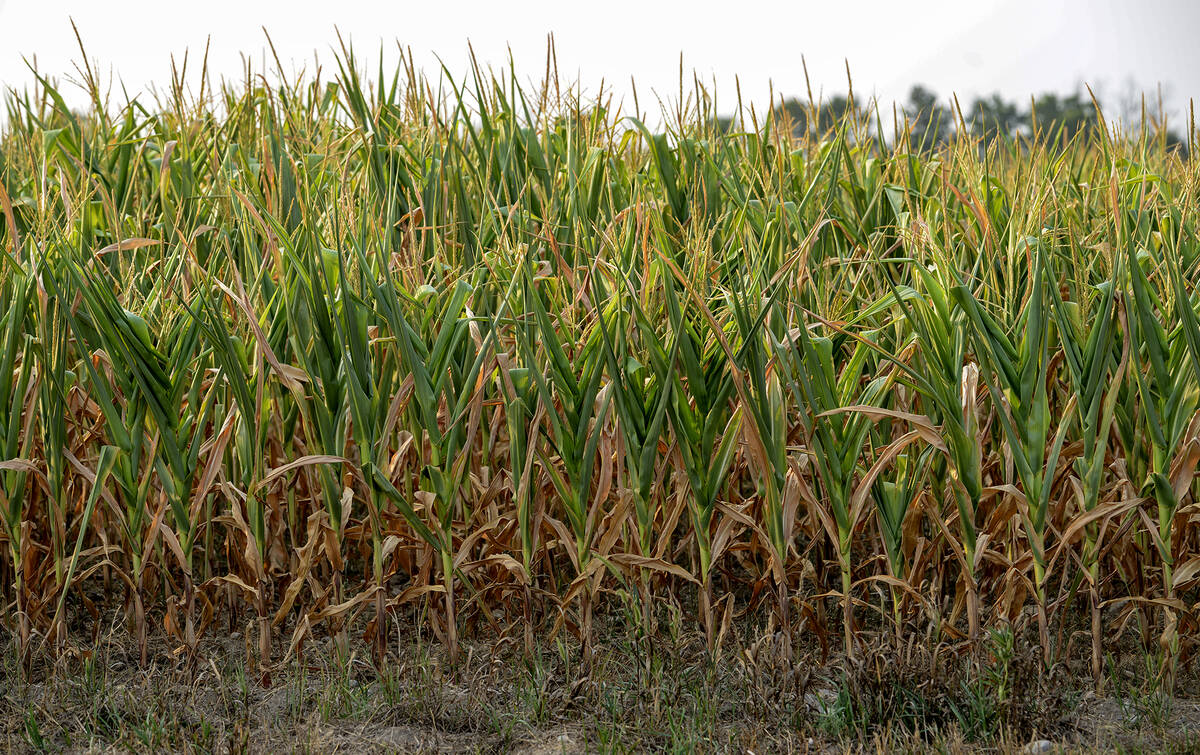Statistics Canada released its Dec. 31 stocks report on Feb. 8. Ontario on-farm wheat stocks were lower than anticipated. The year-over-year increase in wheat production resulted in larger farmer selling. Ontario on-farm corn stocks as of Dec. 31, 2023 were down nearly 600,000 tonnes from Dec. 31, 2022. This will be supportive for the Ontario corn basis. The Ontario corn market will have to ration demand away from export channels during spring and summer.
Quick look
Soybeans: U.S. soybean export sales are running 19 per cent below last year.
Corn: The market will start to factor in lower U.S. production for 2024 in the spring.
Wheat: Ontario soft red winter is competitive on the world market, and there is potential for export demand to increase in April and May.
Dec. 31 soybean stocks were similar to year-ago levels. Ontario soybean exports will now slow and ending stocks for the 2023-24 crop year will be larger than earlier forecasted. Ontario corn, soybean and wheat prices have been relatively flat throughout February due to steady farmer selling and limited export demand.
Read Also

Extreme variability marks Ontario’s 2025 corn crop
The yield potential of Ontario’s 2025 corn crop was lost in some areas due to extreme dry conditions.
Argentina experienced favourable weather during February, enhancing yield prospects for corn and soybeans. The Argentine corn and soybean harvests occur in March and April and export offers are becoming more competitive.
As of Feb. 13, Brazilian farmers had harvested approximately 22 per cent of the soybeans and 35 per cent of the first corn crop. The second corn crop was 30 per cent planted as of Feb. 13. Brazilian soybean offers are a sharp discount to U.S. origin. Brazilian and Argentinean corn offers have come under pressure and are only a small premium over U.S. offers out of the Gulf.
There are no concerns with the Northern Hemisphere winter wheat crop. Russia, France, Germany and the U.S. have received adequate precipitation over the winter, providing favourable conditions when the crop comes out of dormancy. Western Canada has received normal to above normal precipitation over the past 30 days.
U.S. economic growth for the first quarter is coming in stronger than expected, which kept inflation readings elevated. While U.S. growth has supported the Canadian economy, our second and third largest trading partners (China and Europe) continue to experience recessionary pressures. This has kept the Canadian dollar in a consolidation pattern.
The theme from the central banks has been “higher for longer.” The Bank of Canada will likely start to lower rates in the summer but the U.S. Federal Reserve will only decrease its policy rate in the fall. The widening interest rate differential will eventually cause Canadian dollar depreciation against the U.S. greenback.
Soybeans
Ontario on-farm soybean stocks as of Dec. 31, 2023 were 1.16 million tonnes, relatively unchanged from the Dec. 31, 2022 on-farm number of 1.14 million tonnes. Stocks in commercial positions were estimated at 1.118 million tonnes, also unchanged from year-ago levels.
It appears that exporters and domestic crushers have sufficient coverage for their nearby requirements. Basis levels are poised to weaken during the spring and remain under pressure during the summer.
Ontario export offers are a sharp premium to South American values. Off-shore movement will slow, resulting in more supplies available for the domestic crusher. Usually Ontario needs to import soybeans from April through July but import demand will be minimal this year.
Ontario on-farm soybean stocks on July 31, 2024 are projected to be 50,000 tonnes, up from only 18,000 tonnes on July 31, 2023. Lower export demand will result in larger supplies available for the domestic crusher. Farmers will hold back on sales as the domestic crusher fills up.
At the time of writing, Brazilian soybeans were offered at US$403/tonne f.o.b. Paranagua; Argentinean soybeans were quoted at US$426/tonne f.o.b., and U.S. soybeans were offered at US$467/tonne f.o.b. the Gulf. Ontario soybeans were quoted at US$460/tonne f.o.b. St. Lawrence.
The USDA continues to increase the U.S. carryout projection for 2023-24 due to softer export demand. U.S. soybean export sales are running 19 per cent below last year and will slow to a trickle given the sharp premium over Brazil and Argentina.
The U.S. soybean carryout for the 2023-24 crop year is expected to come in at 8.6 million tonnes, up one million tonnes from the previous forecast and up from the 2022-23 ending stocks of 7.2 million tonnes.
U.S. farmers are expected to increase soybean acres this spring. Barring adverse weather, the U.S. soybean market will be in line with Brazilian prices as the market functions to encourage demand.
The Argentinean crop is estimated at 50 million tonnes, which is double last year’s output. The harvest will move into full swing in late March. The increase in Argentinean crush will result in lower export values for meal and oil.
U.S exports of soybean products will also ease in spring and summer, causing the domestic crush margins to deteriorate. The Brazilian crop is expected to finish near 156 million tonnes, down from 162 million tonnes last year. Despite the lower production, Brazilian soybean exports are projected to be 102 million tonnes, up 2.5 million from last year. Brazil has a larger carry-in from 2022-23 due to record output.
What to do: This week, we’re advising farmers to sell 10 per cent of their 2023 soybean production, bringing total sales to 80 per cent. We’re advising producers to sell 10 per cent of expected new crop production, bringing total sales to 20 per cent.
Corn
According to Statistics Canada, total Ontario corn stocks as of Dec. 31, 2023 were 7.7 million tonnes. This was down from the Dec. 31, 2022 supplies of 8.4 million tonnes. Ontario on-farm stocks were 3.7 million tonnes, down 600,000 tonnes from last year. Commercial ownership was four million tonnes, relatively unchanged from 12 months earlier.
Grain companies and end-users are well covered for their March and April requirements. However, the Ontario corn market will need to pull stocks from the farmer from May through August.
To reiterate from the previous issue, export movement is expected to increase during the spring and summer. Given the lower on-farm stocks, domestic users will have to pay a premium at certain times in an effort to curb offshore movement.
During the third week of February, U.S. corn was offered at US$194/tonne f.o.b. the Gulf. Brazilian corn was offered at US$197 and Argentinean corn was quoted at US$196/tonne. South American corn offers have decreased in recent weeks and are now competitive on the world market with U.S. origin. French corn is offered at US$205/tonne f.o.b. La Pallice. Ontario corn is quoted at US$194/tonne f.o.b. St. Lawrence. Ontario corn is competitive with French origin into Ireland and the U.K.
Traders continue to estimate the Argentine corn crop around 55 million tonnes, up from 35 million tonnes last year. The Argentine corn harvest will occur in March and April. Brazil’s first crop corn is estimated at 20 million tonnes and is now being harvested.
Brazil’s second crop is estimated at 95 million tonnes and will come off in June. Total Brazilian corn production is estimated at 115 million tonnes, down from last year’s record of 137 million tonnes. Unlike soybeans, South American farmers sell all their corn.
Argentina, Brazil and the U.S. are jumping over any export business that surfaces. This will change after the Argentine harvest is completed. U.S. values will start to percolate higher later in spring. We’re expecting U.S. farmers to plant 89.5 million acres of corn this spring, down 5.1 million acres from 2023. The market will start to factor in lower U.S. production for 2024. Brazil’s main second crop also moves through the critical pollination stage in late April and May.
The corn market has potential to experience a significant rally during the North American planting period. The lower acreage will make the market extremely sensitive to weather developments.
What to do: We’ve advised farmers to be 50 per cent sold on their 2023 production. Let’s be patient for the spring rally to sell additional volume. We’ll save the final 20 per cent increment in case there is a drought in the U.S.
Wheat
According to Statistics Canada, Ontario on-farm wheat stocks as of Dec. 31, 2023 were 571,000 tonnes. This was down from our estimate of 800,000 tonnes but up from the Dec. 31, 2022 number of 452,000 tonnes.
Ontario farmers sold 2.15 million tonnes of wheat in the first five months of the crop year. The wheat basis is starting to strengthen. Domestic millers need additional coverage for the summer months. Ontario soft red winter is also competitive on the world market with U.S. soft red and French soft wheat. There is potential for export demand to increase in April and May, just prior to the U.S. harvest period.
At the time of writing, the Chicago wheat March/May futures spread was trading at two cents/bushel inverse. The Kansas wheat March/May spread was also at a two cent/bushel inverse. The inverse in the market is a bullish signal. This confirms that commercial traders are narrowing the basis to attract farmer selling.
The funds had a combined short position of 100,000 contracts in Chicago and Kansas wheat. The market is vulnerable to a fund short covering rally on technical strength. These two factors will provide a good opportunity to sell wheat later in March or April.
Russia, Ukraine, France, Germany, and the U.S. all have adequate moisture for when the winter wheat crop comes out of dormancy. Western Canada and North Dakota are also in fairly good shape heading into spring planting.
There is no weather risk premium in the market. Conditions are optimal. If one of the major exporters starts to experience an extended dry spell, we’ll see some strength the market.
To reiterate from the previous issue, Russia has produced two consecutive bumper crops. Exports were 48 million tonnes during the 2022-23 crop year and will reach 51 million tonnes in the 2023-24 campaign. The world has become dependent on Russia for big crops and low prices. If there is a production or export problem in Russia, this wheat market has significant upside.
What to do: We’ve advised producers to be 60 per cent sold on their 2023 production. We’re planning to make our next sale in mid-March. The commercials are bullish wheat at current levels and the market is vulnerable to speculative fund short covering. There is potential for a production risk premium if one of the major exporters experiences adverse conditions over the next month.













